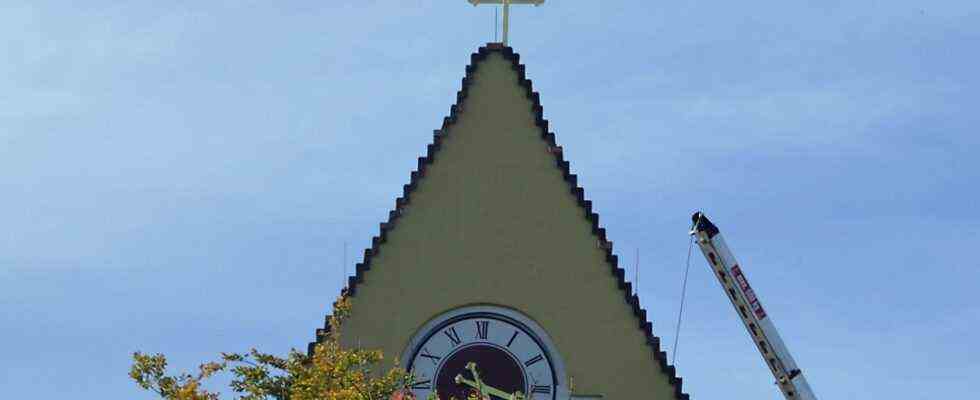The covers have fallen, the tower can be seen again by everyone in Unterhaching after the painting and plumbing work has been completed. The golden cross on the church tower of St. Korbinian and the clock faces shine into the distance. As soon as the renovation work inside the tower has been completed, the hands of the clock will also be restarted. On the double-walled nave, an unusual roof structure should secure the old beams and at the same time make it possible to show the accidentally discovered paintings from the 14th or 15th century.
What is striking about the tower, which is likely to date from the 13th century and which is possibly Upper Bavaria’s oldest tower roof, is that the clock faces are at different heights: on the west and east sides on the fourth tower floor, on the north and south sides in the attic, in the roof gable. This was not always the case, as it is known that the four dials and the mechanical clockwork used to be on the fourth floor. When and why this was changed, Unterhaching’s home nurse Günter Staudter is investigating in the course of his documentation on the construction of the church tower. He can’t say how old the tower clock is either. Its four dials were given a fresh color, the clock hands and the heavily weathered tower cross were newly gilded with a total of 20 grams of gold leaf and made to shine. Staudter has so far found out that today’s electromechanical clockwork was installed in 1972/73 on the second floor of the tower, from where it is connected to all four dials via an axis.
The renovation project for the roof and exterior of the church has been underway since November 20, 2020, the day of St.Corbinian, to which the parish church is consecrated. The damaged roof structure has already pushed the nave walls apart, says church caretaker Herrmann Mader, as can still be seen on the north side under covers. To secure it, the builders put cross braces through the nave. In the course of the roof renovation, the roof was covered, and for the first time daylight fell on the double nave walls, in the gusset of which are the paintings that are now awaiting restoration.
Before that, however, a static problem has to be solved, because the roof structure presses too much on the longitudinal walls of the church. On the one hand, the nave was secured by numerous Y-shaped steel stiffeners; on the other hand, a concept was developed with the aim of showing the paintings to the public in the future. Structural engineer Karl-Heinz Gebhard, architect Martin Spaenle and the specialists from the carpentry company Denkmalbau GmbH Ettersburg worked on this together: The carpentry shop will place a concrete wall cover on the double brick walls of the old part of the nave from above, which will drift the longitudinal walls apart like a bracket hinders. The concrete is reinforced with stainless steel. The roof truss is then placed on the lid in such a way that it is supported by the outer nave walls. The inner nave walls with the paintings are not stressed by pressure from above. “The way in which the roof structure is attached is really special,” says Mader, emphasizing that the original roof structure with its wooden rafters, which may be almost 700 years old, will be retained during the renovation. They are covered by new, load-bearing beams and thus protected.
As soon as the roof structure has been placed on the concrete cover, restorer Peter Siebert can begin to uncover, clean, interpret and secure the paintings while standing on the rubble between the walls. The parish wants to show them to the general public in a photo exhibition. According to Mader, however, they are also thinking about illuminating them and showing them to small groups. As things stand, it could be in 2024.

